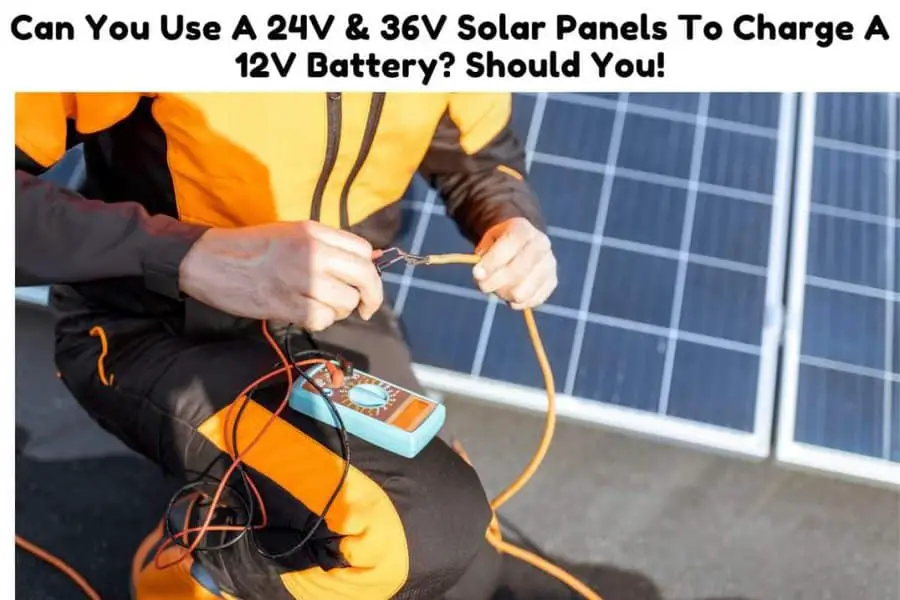There are over 2 million solar panel systems in the U.S alone. Solar is the fastest growing alternative energy source because it is cheap and easy to set up. The average residential solar installation can get up and running in 5 days or less.
DIY installations are very popular since they save up to 15% of the cost of going solar. When you opt to go the DIY route, however, your installation can quickly get complicated if you don’t know what you’re doing. Many questions will come up.
One you will almost certainly face is how many volts can your solar panels be in relation to your battery. For example, can you use a 24V & 36V solar panels to charge a 12V battery?
You can use your 24V & 36V solar panels with your 12V battery. But the question is, should you? In this guide, we cover the basics of matching solar panels to a battery.
On a side note! If you’re in need of a reliable and high-performance portable solar panel, We strongly recommend the Jackery SolarSaga 100W Portable Solar Panel (Amazon Link).
With a high conversion efficiency and foldable design, this solar panel is easy to transport and set up, making it perfect for outdoor activities like camping, hiking, and RV trips.

The US solar cell technology used in this panel ensures that you get the most efficient and reliable solar charging possible.
There is also a 60W option that is more affordable (Amazon Link)

Can You Charge A 12V Battery With 24V?
A 12V battery can be charged with a 24V solar panel. For current to flow, there must be a difference between the source voltage, in this case, solar panels, and the destination voltage, in this case, batteries.
To understand this concept better and help you design an efficient solar energy system you need to know what volts and current are and what the relationship between them is.
Current or charge is the flow of electrons through a conductor. Current is measured in amperes or amps for short. Amps tell you the rate at which electrons in a circuit are moving.
Voltage is what makes current happen. It’s the pressure that pushes electrons in a circuit. It’s just like how water has pressure and flow rate, electricity has voltage and current. To make electrons move from A to B (to create current), you need voltage to push them. Voltage is measured in volts.
Water flows from high pressure to low pressure. Electricity works the same. Current flows from where there is high voltage to low voltage. This is where the concept of potential difference comes from. There must be a difference between the source voltage and the destination or load voltage for current to flow.
What does this mean for your solar panel and battery setup? If your solar panels have a lower voltage than your battery, then they cannot push any current or charge your battery. But how far can you push this rule? What if you have a 36- or 48-volt solar panel?
Can I Use A 36 Volt Solar Panel To Charge A 12 Volt Battery?
A 36-volt solar panel can be used to charge a 12-volt battery. A charge controller is used to regulate the volt output from the solar panel and step it down to the volt input used by the battery.
Electrical systems with higher voltages experience fewer losses when moving electricity from one place to another. It is why the electricity from your grid runs at a high voltage. It’s also why you would want to have your solar array run at a higher voltage.
In the old days, if your solar panels ran at 36 or 48 volts then your batteries had to run at 36 or 48 volts as well. That was, and in some cases still is, the standard design of most solar panel systems.
Thanks to charge controllers, however, you are no longer restricted to exactly matching your solar panel and battery voltages. With a charge controller between them, you can vary the output voltage of your solar panels to suit your needs.
Controllers are there to make sure you don’t overcharge your batteries or drain too much energy from them. In that way, they prevent any long-term damage.
Charge controllers typically have a range of voltages they accept. This information is usually supplied in the specifications or datasheets by the manufacturer.
Can I Use Any Solar Panel To Charge 12V Battery?
Technically it is possible to use any solar panel to charge a 12V battery if the solar panel has the same or higher voltage. The main issues to consider are the capacity of the battery and the power rating of the solar panel.
Solar panels produce a varying amount of energy from tiny hand-held panels that produce 5 watts to large panels that produce up to 400 watts. Will they all charge a 12V battery? As long as they have a voltage of 12V or more, they should.
Choosing which solar panel to use for your battery comes down to answering these three questions.
- How big is the battery? Battery sizes are given in amp hours (AH). The most common battery sizes are 50, 100, and 200AH.
- How quickly do you want to charge your battery? This determines what size solar panel you will get. The more energy or watts your solar panel produces the quicker you will charge your battery.
- How much sunlight will your solar panels get? This will determine how long they will take to fully charge your battery.
Let’s illustrate this with a simple example. Let’s say you have a 100AH battery and you consistently receive 5 hours of peak sunlight. What is the smallest size solar panel you would need to fully charge your battery?
Here you would need a solar panel that produces at least 20AH per hour to fill up your battery. But just to be on the safe side, we need to size our solar panel a little bigger to account for inefficiencies or cloudy days. Instead, we will use a solar panel that produces 30AH.
How many watts is 30AH? To convert amps to watts we multiply the amps by the voltage.
30AH x 12 = 360 watts
To charge a 100AH battery in 5 hours you would need solar panels to produce 360 watts of power. That could be one or two solar panels. Source
Can You Mix 12V And 24V Solar Panels?
It is possible to mix solar panels of different voltages. In this case, single or multiple charge controllers are used to balance or manage the different voltages.
It’s quite common to find a solar system with different panels mixed in. This is often the case if you start with a small solar system to which you decide to add more panels to later. While this can complicate the design of a system, a charge controller is usually the easiest fix. Source
Also, find out “Will A Solar Panel Charge A Dead Battery? What You Need To Know!“
